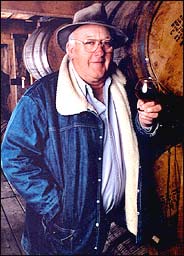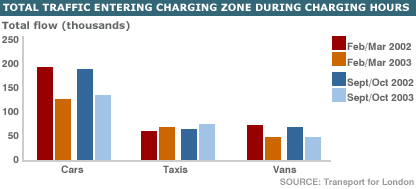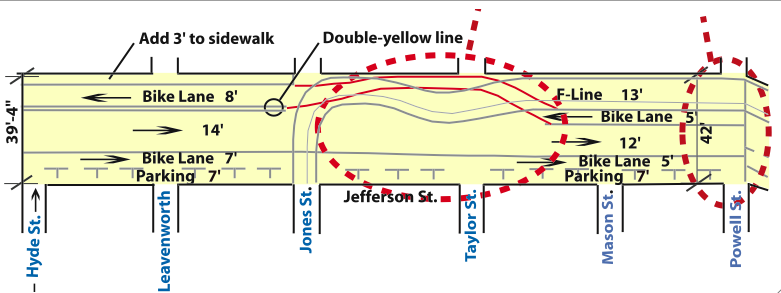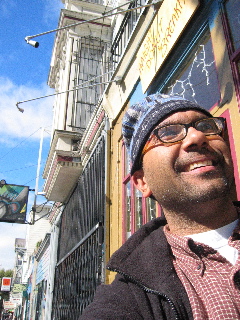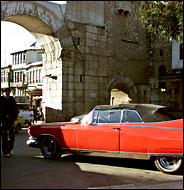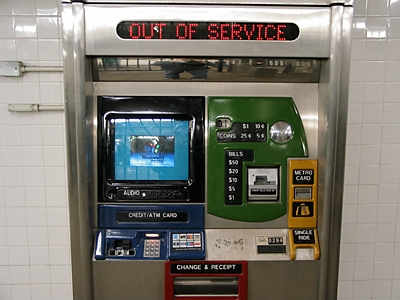February 28, 2004
SEA the city by boat, by train, by foot.
Walking down by the Port of Seattle, Anna and I hopped a ferry to Bainbridge Island. There we walked into the quaint downtown, replete with about six thousand different places to pick up an espresso, and found a chunky little paperback filled with pictures of bicycles around the world.
Upon return to the mainland, we traipsed through the sunshine-filled afternoon -- and who would have expected that sort of weather in Seattle? -- we then rode the Monorail on a two-minute journey which arced prettily through a Frank Gehry-designed Museum.
Seattle runs free bus services through the downtown area between 0600 and 1900: how much does this fareless area promote overall public transit? Portland and Pittsburgh do something similar. San Francisco could promote MUNI by adjust an area between Union Square or Chinatown and the Convention Center, and between the Embarcadero and Van Ness; I think that Jim Reid for Mayor had an idea along those lines.
February 27, 2004
SEA by 'plane.
Upon arrival at SEA, I wondered if one could get downtown by public transit. And it was easy: the online trip planner set us straight, for a $1.25 apiece.
93 pounds per day.
Bestow blessings upon venerable Neldam's Danish Bakery, where 75 years of kringle-eating, cake-devouring, and cake-making all add up to a delicious community.
Within a few miles each of the other, the East Bay boasts such luminaries such as Piedmont's Fenton's and Berkeley's 300-lbs-of-lard Kingpin Doughnuts. And who of the early-risers amongst us can forget Johnny's Donuts in Lafayette?
The Oakland School Board needs this.
Somewhere between laconic street slang and overinformed academic prattle comes
Word.
Bless this Old Tub.
The New York Times' Obituaries section always evinces a bittersweet smile: I enjoy reading about the unusual and strong people on these pages, people who have, perhaps quietly, made a difference in our understanding of the way we live.
Under the headline Master Bourbon Distiller, today I read that Frederick Booker Noe, whose name I first encountered on a bottle of bourbon, died. The 6'4" Booker said: "A respectable amount of bourbon to pour in a glass is about two fingers' worth. Lucky for me I have big fingers." (sound clip at the Small Batch bourbon site).
February 26, 2004
... silver screen, can't tell 'em apart at all ...
Listening to Bowie this morning, thinking about a painter from Pittsburgh.
Scott Blake's digital pointillism might be making a weighty statement about how we have trapped ourself in the measured black-and-white of the automated world, or he might be making cool collages. Or both.
Is our librarians learning?
The Palo Alto Daily News ran a story reporting that the Redwood City Public Library has learned a lesson from San Francisco. Librarians preparing for the upcoming $45,000 renovation of the Schaberg Community Library simply discarded unwanted titles, and did not co๖perate with a local resident who tried to take them to other community organisations.
February 25, 2004
History Lesson Pt. II
Thanks to aram, we have something else to argue about: The Real Top 100 Albums of All time...
Interesting Facts
The appearance of two Sonic Youth Albums, Slint's Spiderland, and My Bloody Valentine's Loveless in the top ten illustrates the strong influence of thirty-something indie-rockers.
Bands with the most appearances on the list
The Beatles - 5 Albums
David Bowie - 4 Albums
Radiohead - 4 Albums
Talking Heads - 3 Albums
Velvet Underground - 3 Albums
February 23, 2004
An otherwise inaccessible location
The oddly-placed Frank Curto Park along Bigelow Boulevard in Pittsburgh ("put it in H!") always made me wonder: who was this poor fellow, that the city would feel an obligation to honor him, but to do so in a slipshod way? Create a narrow park along a busy highway on a bluff over the train tracks, and expect the public to use it?
The STUDIO for Creative Inquiry found a suitable use for the park: installing an Art Garden. Visitors can contribute their own plants to the garden, like a magic penny from the Malvina Reynolds song. Fitting, as Frank Curto was the curator of Phipps Conservatory during the 1970s.
February 22, 2004
To fathom Hell or soar angelic
Some cranks wrote that "by the rules for combining Greek roots, the word should have been psychodelic. They also said that even in the late 70's, psychedelic had mostly been replaced by hallucinogenic". All due to Humphry Osmond, who introduced Aldous Huxley to L.S.D., and who died this past week after a lifetime devoted to research into medicinal uses of hallucinogens.
February 21, 2004
A rubaiyat you could be proud of
Began reading Amin Maalouf's Samarkand,
which chronicles the adventures of a young Omar Khayyam.
The novel, originally in French, mixes a fantastic modern-day tale of the manuscript's redisovery with an account of its creation, just as the Seljuks were advancing across Persia.
Marsh Arabs
This picture appeared on the front page of today's New York Times.

A few months ago, the Week in Review section had a heartbreaking series of photographs on a similar theme.
February 20, 2004
Slave to the turntables
Who thinks these are candidates for worst album covers ever?

I need to find and scan the beautiful cover of Las Limonadas Verdes, the polyester-suited crooners from south of the border.
February 19, 2004
The ring came off my pudding can.
The grand, bright metropolis of Las Vegas sports a shiny new monorail, thanks to the privately-funded non-profit Las Vegas Monorail Co.
This represents a sensible investment for the hotels and businesses who will ease congestion on the Strip, which holds 14 of the country's 15 largest hotels1, hosts many vast conventions, and of course has the slot machines.
The state hopes to appropriate $20 million in federal funds (highway funds?) to to build monorail extensions to downtown and the airport.
1and a developer is building a new, $2.4 billion hotel. B is for billion. Billyun.
In praise of the peanut.
The New York Times has an encomium of the 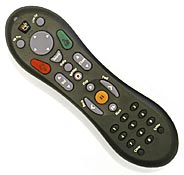 TiVo remote,
TiVo remote,
including commentary by Jakob Nielsen, Mr Usabiility himself (who uses ReplayTV, apparently).
Aside from the distinctive shape (although the vertical symmetry can be disorientating), the remote has beautiful audio feedback: when scanning a program, or navigating the hierachical menus, clear, euphonic sounds provide useful indicators of progress (I can *almost* program the recorder without using the tv monitor!).
And, unlike any other remote in the A/V armada1, I've used every single button 2
1Pioneer DVD player, DirecTv TiVo, Sony A/V Receiver, Sony TV
2The DirecTv model has a whopping 36! TiVo's standard has 30 or 32.
February 18, 2004
De-congestant.
London's Congestion Charge celebrates one year, with mixed success.
Meanwhile, on the Continent, the Toll Collect consortium received a decision from Germany's transportation minister: scrap the entire toll collection plan. After significant implementation delays, the consortium, consisting of Deutsche Telekom, Cofiroute, and DaimlerChrysler, were told to abandon their project.
Transport Minister Manfred Stolpe said the debacle was damaging to Germany's image and a blow to innovation.
I had hoped, in my dreams of becoming Ye President, that this country might develop a similar system in conjunction with our beloved interstate highway system.
February 17, 2004
Don't you know how time zones work?
If only this Flash applet took an argument. So many puerile jokes ensue ...
February 16, 2004
Re-developing Jefferson St.
The Port and the Bay Conservation and Development Commision have chosen plan D to improve pedestrian and bicycle access along Jefferson St.:
The detail drawings provide a finer view of the interaction of parking spaces, bicycle lanes, and MUNI right-of-way; you'll need your imagination to fill in throngs of wandering tourists at the intersection of Jefferson and Taylor intersection and at the Jefferson and Powell intersection.
The SFBC had endorsed a plan that " ... features (from north to south) a dedicated transit lane for the F-line, westbound bike lane, eastbound travel lane, eastbound bike lane, and parking. This would be the most high profile contra-flow bike lane in the city .... It is very important that we get a large turnout at the meetings because of the importance of a continuous bikeway along SF's waterfront."
Bicycle paths, especially ones used less by commuting cyclists and more by casual riders, such as in the tourist-heavy Fisherman's Wharf area, cause me concern when they need to cross turn lanes. In this case, the MUNI F Line crosses the bicycle lane at Jones. Compounding the difficulty of this stretch of bicycle path is the occasionally-cobbled surface of the street, and the MUNI tracks themselves, a trap for the unawares cyclist.
I biked this road almost every single day that I worked near the Embarcadero: one or two of my co-workers and I would hop on our bicycles and zoom down the Embarcadero bike lane, itself well-planned and -executed, and zip all the way along the waterfront to the base of the Golden Gate Bridge. A quick rest there, and then a sprint back through Crissy Field and a return to our desks within the alloted lunch-hour. Splendid.
February 15, 2004
Ground-breaking.
Construction has begun in earnest at the Bank of America branch at Fell and Baker.
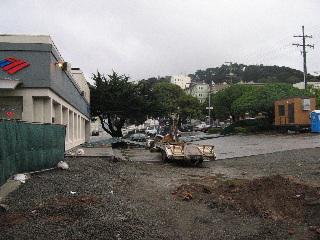
This project, several years in the making, will develop the half-block between Divisadero and Baker and Fell and Oak into a mixed-use area: some underground parking (much needed in the neighbourhood!), ground-floor commerical, and three or four stories of residential, mixed-income units.
Anchor tenants discussed early on in the project included Falleti's, late of Fulton St. (and now replaced by a similar project, involving Albertson's and the City of San Francisco).
February 14, 2004
Raised to a new height.
I have long said that the only commerical enterprises lacking in this neighbourhood (The Lower Haight) are a donut shop and a bookstore.
The two Eritrean women behind the counter told me that the Haight Donut Breakfast opened yesterday. Although the donuts are baked offsite (the Mission somewhere?), the several (ahem) I ate tasted fresh and warm. And delicious: none of the tired All-Star or Inga Donut action here.
The Haight Donut Breakfast occupies the storefront on Haight next to The Top, once home to Botana, and is open from 7 ack emma to 10 pip emma.
February 13, 2004
Learning math at the corner store.
Yesterday I smelled something pleasantly tangy as I walked into a meeting. One of my colleagues was nestling a Wint-O-Green Life Saver candy in his mouth.
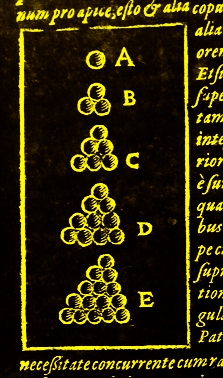
According to this morning's New York Times, scientists have made another important breakthrough in the fascinating field of complex materials theory: the problem of how to most densely pack spherical or round molecules.
February 12, 2004
As Havana, so Damascus.
A 1959 Cadillac Eldorado in the Old City in Damascus.

A 1959 Chevrolet Bel Air in Santiago.
The streets of Havana are famously adorned with gleaming old American cars; so, surprisingly, are the souks and alleys of Damascus.
February 12, 2004
DAMASCUS JOURNAL
The 2004 U.S. Is Unloved, but Not Its Cars of Yesteryear
By IAN FISHER
DAMASCUS, Syria, Feb. 10 Do you like America?
"No," said Majed Aboud, 47, leaving not an inch for doubt. "Because of Bush, they are destroying the world."
So what about all these great cars?
A groan of pleasure escaped the mouth of Mr. Aboud, a mechanic who has spent the last 25 years repairing cars built in the nation he curses.
"Oooohhh," he said. "They are gorgeous."
Like Cuba or Iraq under Saddam Hussein, Syria is condemned to love the cars of its enemy. And Syria's fate a happy one, mostly, to hear it from owners and the people who keep them rumbling along is to see perfectly running vintage American cars everywhere, transported metal and memory of a more carefree superpower: big DeSotos like Art Deco locomotives; a two-toned Chevy Bel Air, its eagle hood ornament sleekly guarding a carpet shop; the Dodge Dart, a car that did not seem like much at the time, but which manages better than its boxier brothers through the narrow streets of the Old City in Damascus, the epicenter of an older, now-vanished empire.
There have been no symbolic burnings of, say, a '57 Chevy, here in this nation outraged that America considers it a state sponsor of terrorism, and which some here fear may be next on Washington's list for pre-emptive regime change. For one, old American cars are too valuable. Syria imposes a triple duty on new cars, so a new Cadillac here costs $150,000 and a new Chevrolet Caprice ranges from $85,000 to $90,000.
Which explains why Dr. Riab Atwan, 46, a gynecologist, happily paid $12,000 two years ago for a beat-up 1977 Pontiac. His car before was a '63 Chevy Impala, before that a '64 AMC Rambler. The color of this latest car, he said, is "champagne," but you have to ignore the blotchy body work.
"In America it would cost $150 or $200," said Manwail Belian, 59, who owns an authorized General Motors service shop, complete with the latest diagnostic computers and racy pin-ups, featuring one woman in a red-white-and-blue bikini.
Dr. Atwan, who had brought his car in for repair, looked startled for a second.
"Maybe that's normal over there," he said with a shrug.
But, he said, he had no regrets: American cars, for whatever price, are all he will buy. "It's strong and safe and large and long," he said of his Pontiac.
Garabad Demerjian, one of two brothers who own a garage near Mr. Belian's in the industrial zone of Damascus, has a theory about why there are so many vintage American cars still on the road here and it has little to do with what Syrians think about America. It is a subject near to his heart, apart from the fact that he fixes American cars for a living.
In 1935, his father, also a mechanic, bought one of the few cars in Syria at the time, a new black Chevrolet that the other day was parked a few feet away from him and his brother, Josep, 44, as they drank tea and read the newspaper.
The car was already 17 years old when Mr. Demerjian was born, and it still ran flawlessly. It still does. To prove it, Josep opened the bulky door and turned the key. It started right away, the sound of the engine big and mellow beautiful, really. The number of American cars still on the road, Mr. Demerjian concluded, is kind of like evolution: the strong made it through.
"You might still find some of the European ones German and French but most of what survived is American," Mr. Demerjian said. (To be fair, Syrian streets have a fair share of vintage Mercedeses, Opels, Peugeots and Audis.) The Americans, he said, "were professionals."
"They were geniuses. These cars were perfect."
Perfection is not a term normally applied to American cars of the late 70's and early 80's. So it is no surprise that a micro-industry has grown up around keeping old American cars on the road. In 1969, the father of Nabil al-Far opened a small shop in downtown Damascus importing parts solely for American cars, and the other day it was still uncomfortably crowded with customers. Mr. al-Far was so busy he could talk to a reporter only between phone calls and orders for parts from the stockroom. Business is great, he said.
"Touch wood," he said, knocking on the counter.
Mr. al-Far can get parts for American cars as old as 1935, though most of his business is for cars built in the 1950's, which makes the cars a decade older than he is. Some parts, like suspensions and axles, are even manufactured in Syria. American cars, he said, are easy to repair and the parts are far cheaper than Japanese ones. And despite the strain in ties between Syria and America, he has no problems getting his products from American suppliers.
He did not want to talk politics, but he conceded that America was not popular in Syria these days. But he saw no chance that Syrians least of all him, who owns a '76 Pontiac and a nice, gray '81 Buick would stop driving American cars if relations between the two countries got worse.
At a juice factory in the industrial zone, a sick, slightly deaf old man named Manoug Najarian sat alone the other day next to the open door of his office, in view of the 1951 DeSoto pickup truck, a faded blue in the sun. His father bought it that year to deliver soda, a sideline to the family juice business. It is the only car Mr. Najarian, 78, has ever owned.
"It is just like my son or my daughter," he said. "It has been over 50 years. This is a long time."
But, it was suggested, a car doesn't talk back to you, like a son or a daughter. "No," he said, "it does talk to me when I turn the key."
His driving days ended after he was hurt in an accident eight years ago. But that did not take the value out of the car.
"I just want to look at it," he said. "That is enough for me. And then I can remember when I was young."
Copyright 2004 The New York Times Company
I prefer men to cauliflowers.
Began reading the much-acclaimed novel The Hours. I was lost by the second word ("hurries") in the Prologue; I've a prejudice against fiction written in the present tense. It's difficult to accomplish, because the immediacy it conveys is muted or contradicted by the fact that the action is obviously in the past (the Prologue describes a death; the second chapter helpfully declares "It is Los Angeles. It is 1949." within a few sentences).
I hoped that Michael Cunningham would abandon the conceit after the Prologue, for which I could have forgiven him. I have read, quite recently, a novel which pulled off the present-tense quite surprisingly, but now I can't remember which.
February 11, 2004
Book of Illusions, Nr. 2
I perused Oracle Night yesterday, but was disappointed. The book-within-a-book1, and the book within that, was brilliant, but everything tapered off so suddenly that I couldn't but think, as I approached the last few pages, that I had a truncated copy of the book. Perhaps this printing left out a hundred pages? I wondered hopefully as the antagonist became clear. But no.
1 The multi-page footnotes quickly irritated me. The digressions might have been more effectively worked into the narrative; Auster has shown that he's good with quick asides. The amount of detail worked into the footnotes was unnecessary and disrupted the succinct flow of the narration.
The action of this book is set entirely in New York, in the boroughs of Manhattan and Brooklyn. And a brief, fantastic trip into Queens.
February 10, 2004
Jackasses abound.
Local to my hood o' hoods, where I was a hooligan and rode around on a phat ol' BMX bike and shot off bottle rockets, we discover that stupidity abounds on both sides of the cyclist-trucker divide:
MONROEVILLE, Pa. (AP) - A bicyclist shot a truck driver in the arm during a confrontation that began when the man pedaling the bike made an obscene gesture, police said.
Feb 9, 2004
Bicyclist Charged With Shooting Motorist in Fight Over Obscene Gesture
The Associated Press
MONROEVILLE, Pa. (AP) - A bicyclist shot a truck driver in the arm during a confrontation that began when the man pedaling the bike made an obscene gesture, police said.
Robert Urick, 41, was charged with attempted homicide, aggravated assault and weapons offenses.
William Nicoletti, 51, told police that when he drove past Urick in his pickup truck Saturday, Urick made an obscene gesture.
Nicoletti said he turned around and drove toward Urick, who pulled out a pistol and threatened to shoot, police said. Officers said Urick then reached into the truck and shot Nicoletti once in the arm, and rode away on his bike.
Nicoletti rammed Urick off his bike and they fought briefly until Urick fled again, police said.
Police said they arrested Urick, of Monroeville, later that day, and he told them he made the gesture because Nicoletti had told him to get off the road.
Urick remained in jail Monday in lieu of $100,000 bail. A hearing was set for Feb. 17.
Tic-tic-tow.
I'm re-reading Motherless Brooklyn.
The action of this book takes place almost entirely in New York City, in the Boroughs of Manhattan and Brooklyn, in a two-day period. Towards the end of the narrative, the protagonist (and narrator) takes his first trip outside of the city limits.
February 09, 2004
Where iTunes end and you begin.
From this morning's Business Day (which on Mondays for the past decade has carried the unnerving subtitle, "The Information Industries"):
Steve Halberstadt of Raleigh, N.C., made such a purchase last week after discovering that Apple's iTunes store, the Web's leading downloadable music outlet, had added "The Whitey Album," a 1995 release by Ciccone Youth, a jokey side project of the rock band Sonic Youth. The album's second track album, "Silence," consists of 63 seconds of exactly that. (The band has said, with tongue in cheek, that the track is a version of John Cage's famous silent composition "4'33"," only speeded up.)
After checking out the 30-second preview, which "seemed to be very representative of the rest of the song," Mr. Halberstadt said he could not help but make the purchase.
He described it as "the best 99 cents I've ever spent''
Using the readers' suggestions, Mr. Miller compiled a playlist of "nine tracks of professionally encoded silence, a total of 6 minutes and 44 seconds of the yawning void," downloadable from iTunes for just $8.91. He noted that as with all iTunes purchases, antipiracy measures allow the silence to be enjoyed on no more than three computers.
February 08, 2004
The south takes what the north delivers.
A quick trip to Mitchell's for the chocolate-dipped, and then a visit to Twin Peaks on one of the clearest days I can recall.
From the heights we could see down to Moffet Field, across to Mount Diablo, and out past Sutro Tower to the Farallon Islands.
February 07, 2004
Do you have any room in that hand-basket?
While playing the Boggle Deluxe smackdown at Chez Shumavon-Riley, Aram could not be stopped from putting on the Ritz.
February 06, 2004
Shook me all night long.
UPDATE:
While San Franciscans pull for a later last call, New York City's mayor is pulling for an earlier last call. The New York Times writer described the propsal as " turning New York after dark into Riyadh after noon".
From the text of a San Francisco Late Night Coalition press release:
Supervisor Aaron Peskin has introduced a resolution at the Board of Supervisors encouraging State Assemblymember Mark Leno to develop legislation to extend the last call for alcohol in bars, restaurants and nightclubs in California's largest Cities. The
SFLNC has previously introduced a similar resolution at the Entertainment Commission, which voted unanimously to support it.
The SFLNC supports this resolution in part because "National Traffic Safety Association data indicates that later last call hours do not increase and may actually decrease the number of alcohol related traffic fatalities"; but what of the potential increase in police, fire-fighting, and EMS personnel costs due to later business openings? The cost of having restaurants open later may not be offset by additional tax revenue.
After adoption by the City, the State Senate will need to take up the issue.
February 05, 2004
Flat tire for Caltrain.
From the 5.05 from San Antonio:
Just after leaving the Menlo Park Station, the conductor announced over the intercom that we had a flat tire and were slowing to a halt to see if we could fix it. Did I hear aright?
The Atherton police seem to have blockaded the tracks ahead; we're stopped within sight, perhaps a hundred yards in front of, the Atherton platform.
... everyone is asking the conductor about debarking from the train. Of course, because we're before the Atherton station, no-one can get off.
UPDATE:
The area was taped off as a crime scene; a body bag was visible from the train. I took some photos, and we'll see if any of them turn out.
UPDATE:
From the Chronicle's local news roundup:
A suspicious package addressed to President George W. Bush was detonated by a water cannon at an Atherton train station Thursday, authorities said today.
A postal worker noticed the box in the mail drop at the Caltrain station around 5 p.m. and called police, who in turn called the San Mateo County Sheriff's Office bomb squad, according to sheriff's spokeswoman Bronwyn Hogan.
Hogan said once it was discovered that the parcel was addressed to the president, the U.S. Secret Service and the Bureau of Alcohol, Tobacco, Firearms and Explosives were called in to investigate.
Following an examination of the possible device, the bomb squad blew apart the box with a water cannon, Hogan said.
Authorities are still investigating the parcel and whether or not it was an explosive device. No suspects have been identified.
Trains did not stop at the station and were delayed for more than an hour during the operation, according to Caltrain spokeswoman Jayme Maltbie Kunz.
February 04, 2004
The reading habits of the SOMA-bound commuter.
On this morning's N-Judah, I noticed that everyone in the first car was reading.
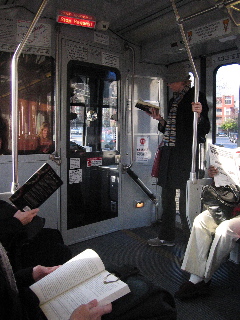
The woman closest to me had an asymmetric heart-shaped bookmark which she had to move each time she turned the page; the woman next to her was agitatedly reading "The Terrible Coil" and nervously looking around; the woman across from her was paging through the San Francisco commuter's treat, The Examiner (whose masthead, I noticed today, has a period after the name: "The Examiner."); standing next to her was a woman cooly reading a paperback.
Everyone, that is, except me: no words in front of my eyes;I was rockin out to The Fall. I picked up an Examiner at the Caltrain station, though, so I could look at the three or four remaining comic strips (down from two full pages just a few months ago) and read the coverage of the Central Freeway development.
February 03, 2004
The true object of my visit is:
Over a workplace espresso yesterday, John recommended Bulgakov's
Reviving an extinct art.
How many ways do you know to scam MetroCard fares?
http://www.nytimes.com/2004/02/03/nyregion/03subway.html
February 3, 2004
MetroCard Dispensers Breaking Down, Victims of Tampering and Their Own Success
By MICHAEL LUO
Not quite nine months after the orange, yellow and blue MetroCard became the only way to get through a subway turnstile in New York City, transit workers are called to fix the vending machines that dispense them roughly 800 times a day with 1,637 machines in the entire system, statistics show.
With each muttered curse from a passenger as a missed train rumbles past, the token's flashy, flexible replacement the centerpiece of an ambitious vision of a 21st-century transit system is securing its place in the city's landscape as something to complain about.
"It affects everybody," said Rey Labron, 39, a messenger in Harlem, as he stood in line at a subway booth at East 125th Street because all three MetroCard machines in the station were scrolling the red message "Out of Service" on their L.E.D. displays. "It makes you go to work late when you have to wait on a big line."
To be fair, some repairs involve repeated problems at the same machines, and most of the time the machine is not completely out of order. More often, it is not taking bills, or is refusing to dispense single-ride tickets, or is experiencing some other problem that does not make it absolutely impossible to buy a MetroCard - although that may be little solace to the rider whose bill a machine will not take. And often, the problem cannot be blamed on the machine but rather on the scam artists who have tampered with it. With repeats figured in, officials estimate that about one-third of all the machines are getting some type of service each day.
MetroCard machine repairs have nearly doubled since tokens were eliminated in May, and New York City Transit is looking to increase its crew of MetroCard machine maintainers by 60 percent, to 108, at a cost of $3 million, even as many of its other departments endure cutbacks.
Call it the price of change.
The half-century-old subway token was no match for the MetroCard, its high-tech replacement. MetroCards are critical to transit officials' visions of a 21-century subway system, in which riders buy their fare cards from vending machines, follow electronic voices and signs and ride trains that are controlled almost completely by computer. As part of this effort, the transit agency closed 45 subway booths last August, replacing them with MetroCard vending machines. Seventeen more are to close in coming months.
But by now, most New Yorkers are deeply familiar with occasional MetroCard frustration: entire rows of machines out of order; long lines behind the only working machine or the only one that will take cash; getting to the front of the line to have a machine eat your $5 bill or to discover that it will not take your credit card.
"Just give me my token and let me use it," said Darryl Gates, 39, a journeyman at the Fulton Fish Market, looking to buy a single-ride card from a machine that was being fixed on a recent morning.
The root of the problem, officials said, is not the machines themselves but vandalism and the demands of a 24-hour transit system. Over all, they said, the MetroCard system is a huge success. "There's always going to be issues," said Steven Frazzini, vice president of MetroCard program management and sales, pointing out that the machines processed more than 101 million transactions last year. "They're getting a lot of use."
The nation's second-largest municipal rail system is Chicago's, which carries 1.5 million riders a day, compared to more than 4 million in New York. In Chicago, fare cards are sold only through vending machines, and repair crews respond to about 60 calls a day for 340 machines, a spokeswoman for the Chicago Transit Authority said. In Washington, whose subway system transports 650,000 riders a day, fare card machines work 99.6 percent of the time. But Washington's system and parts of Chicago's shut down overnight. All three cities use machines made by the same manufacturer, Cubic Automated Revenue Systems.
After the vending machines' initial rollout in 1999 in New York, they were failing far more often than transit officials had promised - once every 2,000 transactions, instead of every 10,000 transactions. But after some adjustments, the machines now fail at a rate of about once every 12,000 transactions. The number is deceptive because it does not take into account common headaches like the bill handler getting jammed with an old bill.
"A customer has five one-dollar bills, two fives and a ten," said Paul Korszak, assistant vice president of MetroCard sales and customer service. "It just takes one of those out of a sweaty pocket to introduce a jam."
The problems have created more than a few busy days for the mobile teams responsible for keeping the machines running. Louis Maldonado, 39, and his armed partner, Michael Hickman, 61, were camped the other day in front of two machines at the William and Fulton Streets entrance of the Broadway-Nassau subway station. After fixing a half-dozen machines at another station earlier in the morning, they arrived to find the two machines not taking bills.
The problem turned out to be vandalism: Mr. Maldonado reached into both machines and fished out MetroCards stuck in their bill-handling units.
Of 25,382 repairs in December, 16,936 involved the bill-handling unit. About 45 percent of these - or 30 percent of all repairs - were caused by tampering. The tamperer's goal is to break the machine so that riders will be forced to use the services of a person who just happens to be waiting nearby with a handful of unlimited-ride day passes offering to swipe people through for $2.
"They start a transaction," said Antonio Suarez, chief officer of automated fare collection equipment maintenance for the transit agency. "Instead of money, they introduce a card or a foreign object."
"What these guys will do is they will purchase multiples of those cards and just switch them as they're swiping people through and charge them two bucks apiece," said Paul J. Browne, the chief spokesman for the New York City Police Department.
The scam was in full view on a recent afternoon at the station at 125th Streeet and Lexington Avenue, where a group of men jostled to swipe riders through the turnstiles. All three MetroCard machines in the station were out of commission.
Officials say the scam represents an evolution of the extinct art of "token sucking," in which a person would clog the token slot with a matchbook or even glue. After the stymied rider walked away, the token sucker would clamp his lips over the receptacle and suck the token out, then turn around and resell it. The scam produced repair headaches similar to those the transit agency is experiencing with MetroCard. Repair crews used to fix turnstiles at a clip of about 250 a day, about 60 percent of them because of paper stuffed in the token slots.
Some of the swipers of today, as they are nicknamed, have stumbled upon a MetroCard quirk in which someone can bend a discarded card a certain way, then swipe it through a card reader three times quickly and somehow end up with a $2 credit.
A man who called himself Charlie and said he was 31 demonstrated for a reporter at the station at 103rd Street and Lexington Avenue.
"I can make $200 or $300 a day," he said. "This morning, I got here at 11. By 11:30, I made $25. Then I went to 125th Street. Up there, I made $30 in 15 minutes."
"The most I ever did was $250," he said. "That day I worked from 9 in the morning until 5."
Transit officials confirmed the problem but said it had not been fixed because that would make it harder to swipe legitimate cards through the turnstiles.
Officials for Washington's Metro said that their fare card dispensing machines were almost never tampered with and that fare swiping was not a problem, largely because riders were required to insert their fare cards when they went through the turnstiles to the subway and when they exited. Officials in Chicago reported a similar lack of vandalism.
After finishing with the two machines at Broadway-Nassau, Mr. Maldonado and Mr. Hickman moved on to the Chambers Street station of the C and E lines, where swipers had struck as well. Mr. Maldonado had planned to start on the southern end, where one machine was out, but after calling in to his headquarters, he learned of an "all out" condition on the other side. When he arrived, he found three broken vending machines, two of them unable to accept bills and a third unable to accept bills or dispense single-ride cards.
Swipers can be charged only with a transit violation, "unauthorized fare media," which carries a fine of $65 or occasionally a jail sentence of one to two days, Mr. Browne said. Because the crime does not rise to the level of a misdemeanor, he added, an officer must see the fare swiper in the act more than once to make an arrest.
Legislation is pending in Albany to elevate the crime to a misdemeanor. Even so, police officers made 2,033 arrests for fare swiping last year, with the monthly arrest average jumping from 134 to 194 after tokens were eliminated. Officers also issued 1,600 summonses for fare swiping.
Another frequent problem is with what officials call the "fare card transportation module," which processes, encodes and dispenses MetroCards. Problems with the fare card system account for about 13 percent of repairs. The rest are typically for the single-ride-ticket dispenser, the coin-accepting mechanism or the receipt system.
Officials said they had tried to build redundancies. If the bill accepter is not working, customers can use credit cards. If the MetroCard dispenser does not work, they can buy single-ride cards. In the rare case when a machine is completely out of service, they can go to a station agent, or try one of the 600 express machines throughout the system, which take only credit and debit cards and seldom have problems.
But the problems with the bill handler are clearly a concern because about three-quarters of transactions at MetroCard machines are in cash. The best they can do, officials said, is to get to the problems more quickly.
The turnaround time for fixing a machine has improved. Machines were out of order anaverage of 15.7 hours in June, a month after the token was eliminated. That dropped to a low of 10.4 hours in November, largely because officials switched to an overlapping shift system that made sure workers were on hand at busy hours. They also asked their workers to work overtime and added extra weekend crews.
Mr. Maldonado and Mr. Hickman finished up with the three machines at Chambers Street and headed south to the World Trade Center station. Swipers regularly position themselves at the unsupervised entrance, so they decide they should check it before they move on.
Sure enough, five out of six machines had error messages.
"They were here," Mr. Maldonado said.
He set down his bag and got to work.
Colin Moynihan contributed reporting for this article.
Copyright 2004 The New York Times Company | Home | Privacy Policy | Search | Corrections | Help | Back to Top
February 02, 2004
Belly-aching on the N-Judah.
This morning I stood at the counter of Coopers, drinking my "regular" (or, as Jeremy, the Monday-morning barista, calls it: "a medium double shot") and counting MUNI LRVs. A confusing number passed through the already-confusing intersection of Steiner, Duboce, and Sanchez. The 7.41, as expected; and then, close on its heels, another 2-car N. I checked the clock and then figured to catch the next, since it'd be the 7.55, and that would get me to my Caltrain connection well before its departure time of 8.37. But behold! a mere five minutes later, another N rolled past, and I polished off my drink and decided to walk down to the stop to catch the next one. And barely had I walked out into the rainy Monday morning when I heard the familiar uphill rumble of the train leaving the Duboce Park stop.
I dashed to the head of the train ("Riders paying cash fare must board front door of first car") and waited as it jerked once, then twice, to a stop.
The congestion (four Ns in under 20 minutes) led to a bottleneck in the Market Street Subway: we paused for a minute in the tunnel before Van Ness, and then again before Civic Center: a K-Ingleside was sitting on the tracks in front of us. Finally the driver opened the doors as we sat at the west end of the platform. A very large passenger covered in a blue tarp (to keep the rain off?) huffed as she climbed on to the train. "This is the improved MUNI service?" she bellowed to no-one in particular.
Her mutterings grew louder when we sat on the tracks again before the Embarcadero stop, where she invoked curses against the new $45 FastPass; she cast aspersions upon the station-agent at the Embarcadero ("he can't be on a break already! It's only 8.15!") and then against the driver of our car itself ("not even an annoucement! This is our tax dollars? This is our fare money?!") when we sat for quite some time in the tunnel before The Embarcadero. (There was a signal failure, as the driver announced once he got the word over the radio.) She variously cursed the FastPass at $25 and then at $45, but never spoke too loudly. A sympathetic face appeared at Folsom Street, and she began railing against the people of the land of the brave: "This is what passes for a train system in this country. In any other country, people would raise a ruckus." The sympathetic face grew despondent and turned to me for an escape, but I raised my newspaper higher and left the face to deal on its own.
February 01, 2004
Detour, boss, detour.
Beginning tomorrow, Octavia Boulevard is in full effect.
Construction will continue around the elevated Central Freeway; a new offramp will be built down past Zeitgeist on to surface-grade at Octavia.

